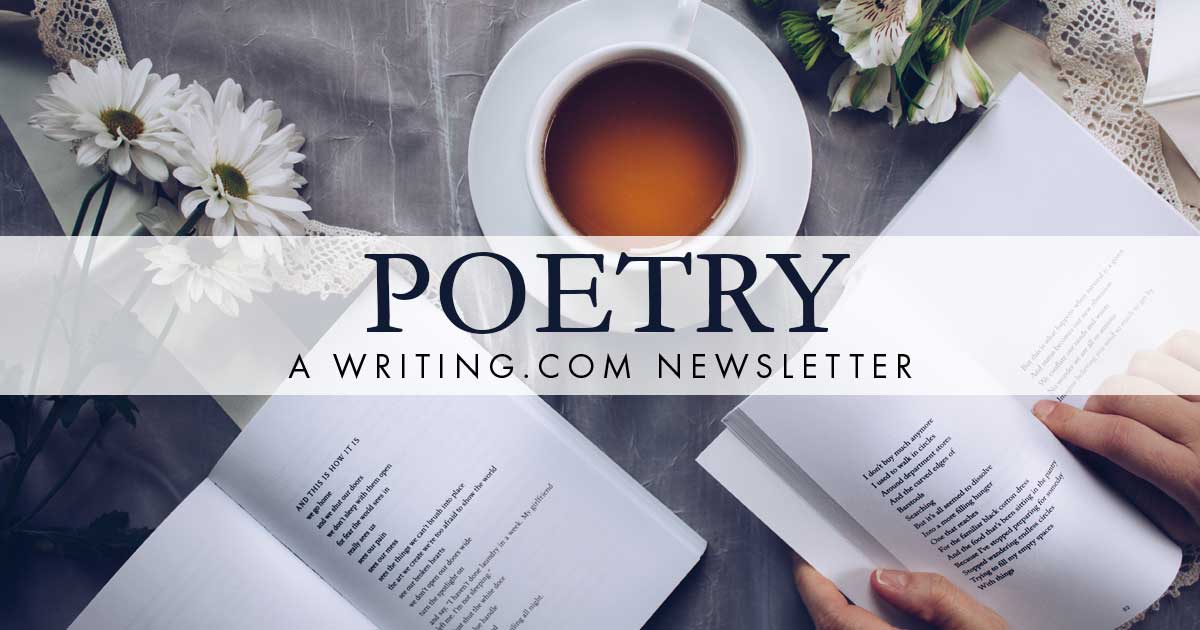This week: The Structure of Free Verse Edited by: Warped Sanity  
More Newsletters By This Editor 
![Table of Contents [#401437]
Table of Contents](https://www.Writing.Com/main/trans.gif) ![Table of Contents [#401437]
Table of Contents Table of Contents](/main/images/action/display/ver/1709303267/item_id/401437.png)
1. About this Newsletter
2. A Word from our Sponsor
3. Letter from the Editor
4. Editor's Picks
5. A Word from Writing.Com
6. Ask & Answer
7. Removal instructions
![About This Newsletter [#401439]
About This Newsletter](https://www.Writing.Com/main/trans.gif) ![About This Newsletter [#401439]
About This Newsletter About This Newsletter](https://www.writing.com/main/images/action/display/ver/1709303676/item_id/401439.png)
| One way of enhancing the emotional content of a freeform poem is through various types of linebreaks and utilizing punctuation to strengthen a line or phrase. In this newsletter, you will learn some of the structural elements used in creating freeform poetry. |
![Word from our sponsor [#401440]
Word from our sponsor](https://www.Writing.Com/main/trans.gif) ![Word from our sponsor [#401440]
Word from our sponsor Word from our sponsor](https://www.writing.com/main/images/action/display/ver/1709303724/item_id/401440.png)
| ASIN: 1945043032 |
|
Amazon's Price: $ 13.94
|
|
![Letter from the editor [#401442]
Letter from the editor](https://www.Writing.Com/main/trans.gif) ![Letter from the editor [#401442]
Letter from the editor Letter from the editor](https://www.writing.com/main/images/action/display/ver/1709303784/item_id/401442.png)
Enjambment is the continuation of a sentence or clause over a line-break. One thought is presented then continued on another line. Usually, poets use this to enhance the preceding line. Take the introductory lines to the poem Mending Wall by Robert Frost for example. Notice how each line enhances the preceding lines, unraveling the story?
Something there is that doesn't love a wall,
That sends the frozen-ground-swell under it,
And spills the upper boulders in the sun;
And makes gaps even two can pass abreast.
End-stopped lines conclude with a strong form of punctuation like a period. Unlike how enjambment lines end then continue the subject onto the next line, end-stopped lines conclude the thought. Sometimes poets will utilize end-stopped lines as a standalone line to force the reader to pause before reading on. The poem The Last Laugh, by Wilford Owen is full of end-stopped lines. Take notice on how the independent lines enhance the emotiveness of the poem. Caesura, which will be discussed next, is also used throughout this poem.
‘O Jesus Christ! I’m hit,’ he said; and died.
Whether he vainly cursed or prayed indeed,
The Bullets chirped—In vain, vain, vain!
Machine-guns chuckled—Tut-tut! Tut-tut!
And the Big Gun guffawed.
Another sighed,—‘O Mother,—mother,—Dad!’
Then smiled at nothing, childlike, being dead.
And the lofty Shrapnel-cloud
Leisurely gestured,—Fool!
And the splinters spat, and tittered.
‘My Love!’ one moaned. Love-languid seemed his mood,
Till slowly lowered, his whole face kissed the mud.
And the Bayonets’ long teeth grinned;
Rabbles of Shells hooted and groaned;
And the Gas hissed.
A caesura is a strong pause within a poetic line. For example purposes, I've used a stanza from I’m Nobody! Who are you? by Emily Dickenson. All lines, except for line three use caesura.
I’m Nobody! Who are you?
Are you – Nobody – too?
Then there’s a pair of us!
Don’t tell! they’d advertise – you know!
Parsed lines break where a speaker would naturally pause or take a breath, such as between independent clauses. Sometimes, the use of parsed lines can create sarcasm, such as in the last two lines in the below stanza from Litany in Which Certain Things Are Crossed Out by Richard Siken.
Who am I? I’m just a writer. I write things down.
I walk through your dreams and invent the future. Sure,
I sink the boat of love, but that comes later. And yes, I swallow
glass, but that comes later.
Later in the poem, he uses parsed lines with:
Love always wakes the dragon and suddenly
flames everywhere.
Of course, this is just a glimpse at how free verse poets use literary elements to structure their verse. There are many others. What element are you most fond of using in your own poetry?
|
![Editor's Picks [#401445]
Editor's Picks](https://www.Writing.Com/main/trans.gif) ![Editor's Picks [#401445]
Editor's Picks Editor's Picks](https://www.writing.com/main/images/action/display/ver/1709303830/item_id/401445.png)
All the poems below are some of the previous winners in the "Rebel Poetry Contest"  who have used the elements discussed above. who have used the elements discussed above. 
| |  | Invalid Item 
This item number is not valid.
#2128070 by Not Available. |
|  | Just Fine  (18+) (18+)
It's easier that way, isn't it? For the Rebel Poetry Contest.
#2144654 by Kit   |
| |  | Invalid Item 
This item number is not valid.
#2179607 by Not Available. |
|
![Word From Writing.Com [#401447]
Word from Writing.Com](https://www.Writing.Com/main/trans.gif) ![Word From Writing.Com [#401447]
Word from Writing.Com Word from Writing.Com](https://www.writing.com/main/images/action/display/ver/1709303874/item_id/401447.png)
Have an opinion on what you've read here today? Then send the Editor feedback! Find an item that you think would be perfect for showcasing here? Submit it for consideration in the newsletter!
https://www.Writing.Com/go/nl_form
Don't forget to support our sponsor!
| ASIN: B0CJKJMTPD |
Product Type: Kindle Store
|
Amazon's Price: $ 4.99
|
|
![Ask & Answer [#401448]
Ask & Answer](https://www.Writing.Com/main/trans.gif) ![Ask & Answer [#401448]
Ask & Answer Ask & Answer](https://www.writing.com/main/images/action/display/ver/1709303902/item_id/401448.png)
![Word from our sponsor [#401440]
Word from our sponsor](https://www.Writing.Com/main/trans.gif) ![Word from our sponsor [#401440]
Word from our sponsor Word from our sponsor](https://www.writing.com/main/images/action/display/ver/1709303724/item_id/401440.png)
| ASIN: 1945043032 |
|
Amazon's Price: $ 13.94
|
|
![Unsubscribe [#401452]
Removal Instructions](https://www.Writing.Com/main/trans.gif) ![Unsubscribe [#401452]
Removal Instructions Removal Instructions](https://www.writing.com/main/images/action/display/ver/1709303960/item_id/401452.png)
To stop receiving this newsletter, click here for your newsletter subscription list. Simply uncheck the box next to any newsletter(s) you wish to cancel and then click to "Submit Changes". You can edit your subscriptions at any time.
|
